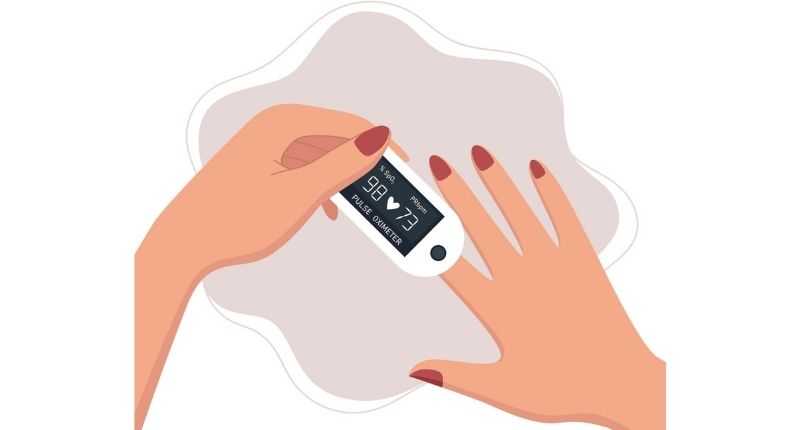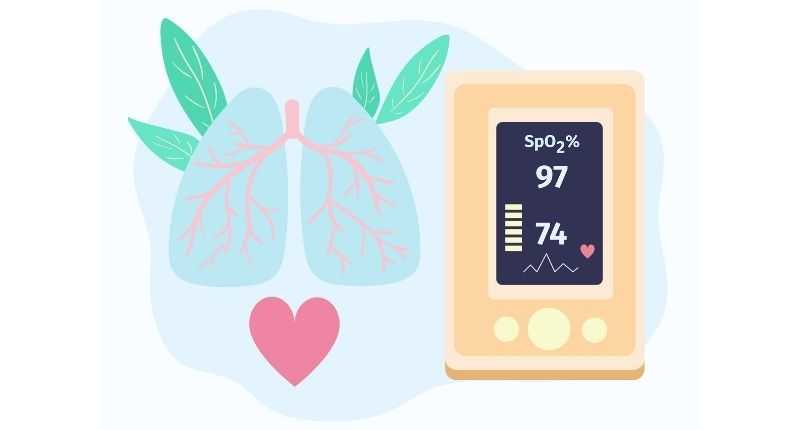A pulse oximeter is a useful home technology – especially amid the pandemic. It helps measure blood oxygen levels and heart rate. To fully leverage the tool; however, it’s best to first understand how it works.
A pulse oximeter measures the heart rate using sensors, light source, and photodetector. It detects changes in the levels of visible light passing through the body tissues. It then interprets the resulting waveform into heartbeats per minute.
Here’s a breakdown of the physics for a better understanding.
What is a Pulse Oximeter?
A pulse oximeter is a light and small device that resembles a clip. It’s attached to a finger to measure oxygen saturation levels and heart rate – in a non-invasive manner. You can also attach it to your toes and earlobes.
The device consists of a microprocessor unit and a peripheral probe. It displays:
- A waveform
- The averaged pulse rate, and
- The estimated blood oxygen saturation percentage.
The gadget boasts an alarm that sounds in cases of:
- Low SpO2
- Too high pulse rate
- Too low pulse rate
How Does a Pulse Oximeter Measure Heart Rate?

The pulse oximeter uses two sensors, a red & infrared light source, and a photodetector. These parts help measure the amount of visible light transmitted through the tissue.
The device displays the changes in light level in a waveform. It then calculates the ratio between the amplitudes of red and infrared wavelengths.
The oximeter then uses empirical calibrations to match the ratio to a given heart rate. ratio.When the heart contracts, it pumps blood into blood vessels. The vessels then transport the blood throughout the body.
Each heart contraction squeezes blood into the blood vessels, slightly enlarging their capacity. When the heart relaxes, the vessels return to their original capacity. And the cycle continues.
The change in capacity affects the amount of visible light transmitted through the blood vessels.
The pulse oximeter captures these light fluctuations in a waveform. And calculates the ratio between the amplitudes of the red and infrared wavelengths. The device then uses empirical calibration to match the ratio with a heart rate and SpO2 value. Note, the empirical calibrations are a result of studies done on healthy volunteers.
The Time Difference
The oximeter readings often lag behind a person’s actual condition. That’s a result of the response delay from averaging light signals on the detector. The delay can be set on the oximeter for 4, 8, or 16 seconds, with most devices having a default setting of 8 seconds.
Interpretation
Normal arterial oxygen saturation ranges between 97% and 99%. Some individuals, especially smokers, may have an oxygen concentration between 93% and 95%. Readings of 90% and below require medical attention.
(Scientifically, over 89% of your blood should be carrying oxygen. The goal is to keep cells and the entire body healthy. A temporary low oxygen concentration may not be harmful. But consistent or repeat instances of low oxygen concentration levels can be damaging.)
What is the Accuracy of Pulse Oximeters?

Quality pulse oximeters have a 95% confidence rate with an accuracy of ±4%. Thus, oximeters give reliable readings if the readings are between 70% and 100% SpO2.
Most devices provide readings within a 2% difference. Thus, if your reading is 95%, your true blood oxygen saturation level may be anywhere between 93% and 97%.
The following factors can affect the accuracy of the reading:
- Improper placement of the probe
(The detectors and light emitter must be on opposite sides. Also, the light must reach the detector only through the body tissue.)
- Cold fingers or fever
- Changes in pH
(Ensure the finger or the body part in question is sweat-free.
- Edema
(Venous congestion of the limb decreases arterial pulsations signals.)
- Movement
(Think improperly seated sensors, seizures, shivering, or parkinsonian tremors.)
- Carbon monoxide waveform
- High-intensity lighting like fluorescent lights
- Nail polish or artificial fingernails
(Especially in cases of green, blue, and black nail polish.)
Why Should I Have a Pulse Oximeter at Home?
A pulse oximeter helps determine how well your heart is pumping oxygen through the body. You can; thus, use it to track health conditions that can affect heart rates and blood oxygen levels.
Such conditions include:
- Asthma
- Pneumonia
- Chronic obstructive pulmonary disease (COPD)
- Heart failure
- Lung cancer
- Anemia
- Congenital heart defects
- COVID-19
Having a pulse oximeter at home is particularly helpful amid the pandemic.
In her 18-minute video “Guide to Managing Mild Cases of Covid-19” Dr. Sandhya Ramanathan, an Auckland-based GP encourages people to invest in a pulse oximeter, and for reasons.
She says, “People with respiratory illnesses including Covid-19 are at risk of low oxygen saturation levels in the blood.”
She continues, “It became clear in the early stages of the crisis that many people were unaware their oxygen levels were dipping until it was almost too late.”
Ramanathan suggests that people should track their oxygen concentration levels daily. Especially for the first 14 days after diagnosis with COVID-19.
She notes the normal rate ranges between 95% and 100%. She encourages medical intervention if the SpO2 levels dip below 93%. Or when there’s shortness of breath.
Prof Sam McConkey, an expert in infectious diseases at the Royal College of Surgeons in Ireland, backs her views.
He notes that “Some patients with Covid-19 don’t develop symptoms of hypoxia such as shortness of breath or even coughing, and report as being merely tired.”
He continues, “But the illness can be silently ravaging their lungs, causing their oxygen levels to drop to dangerously low levels before they are even aware of it.”
Nigel Watson, chief executive of Wessex Local Medical Committees points out that, “The evidence is now fairly strong that if oxygen saturation falls to 94% or 93%, the mortality risk increases to around 13%. And if it falls below that, the risk level can increase to about 28%.”
Expert notes that patients who develop “silent hypoxia” tend to require IVS (invasive respiratory support). And even then, the outcomes are very poor. (“Silent hypoxia” is a condition where oxygen desaturation occurs without exhibiting the obvious symptoms – like shortness of breath.)
As such, it’s important to have a pulse oximeter to track blood oxygen levels and heart rates. Especially now that approximately 80% of Covid-19 cases are managed at home.
What to Consider When Buying a Pulse Oximeter in Ireland?

Ask yourself the following questions when selecting a pulse oximeter.
- How accurate are the readings?
- How easy is the oximeter to use?
- Will the device alert me when I place my finger incorrectly?
- Is the display large enough?
- Is the oximeter reliable when motion artifact is expected? Or can only take a single reading?
- Can it work on different finger sizes – from small to large?
- Can it lose its accuracy with prolonged use?
- How long will the oximeter remain functional?
- How are the manufacturer’s customer service and warranty?
Always strive to buy a pulse oximeter that’s certified by relevant medical bodies. You should also buy from a reliable vendor.
Read More: Volcano Vaporizers by S&B
Any Recommendations?
You can count on these pulse oximeters to give a quick and accurate insight into your heart rate. And by extension your blood oxygen levels.
The Budget Oximeters
The CONTEC D1 CMS50D1 is an affordable option when it comes to pulse oximeters. This device features an OLED display which shows you the blood oxygen level reading clearly. In fact this option gives you 6 different display views to read your results the way you like and is product tested.
Another budget pulse oximeter is the JUMPER Pulse Oximeter. This device is digital with an LED display and also comes with a carry case and batteries plus a lanyard.
The Smart Oximeters
Beurer PO60 Pulse Oximeter with Bluetooth is a high-tech, smart pulse oximeter created to measure heart rate and oxygen saturation levels.
This model is specifically made for those with medical conditions in mind. Data from this pulse oximeter is transferred wirelessly from the device to your smartphone for convenience and ease-of-use.
The second smart oximeter I’ve chosen for you is another wireless option. The Wireless SpO2 Pulse Oximeter not only captures heart rate data and oxygen saturation levels but also doubles up as a sleeping device. It acts as a sleep monitor too for those who suffer from sleep apnea and snoring.
The Investment Oximeters
Pulse Oximeters come in many forms with some requiring a big investment. If you have a medical condition which requires regular use of this device then why not invest in the Viatom Wrist Pulse Oximeter. This wrist version makes tracking your blood oxygen saturation much easier and consistent.
Not only does this wrist pulse oximeter work to collect blood oxygen saturation data over night but is also has a vibrating alarm for snoring and/or sleep apnea.
Conclusion
Having a reliable pulse oximeter at home is important – especially amid the pandemic. You can use it to easily track your vitals, and seek medical attention early on – if need be. Use the questions listed in this guide to inform your decisions. Or select an oximeter from our recommended list for a quick, reliable purchase.

